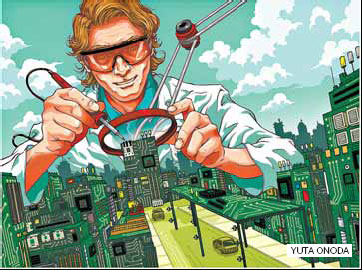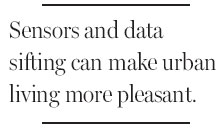City life under a microscope
Updated: 2013-03-10 07:50
By Steve Lohr(The New York Times)
|
|||||||


The notion of a "science of cities" seems contradictory. Science is theory and precise measurement, while cities are messy agglomerations of people and human foible.
But science is precisely the ambition of New York University's Center for Urban Science and Progress. Founded last year, the center's initiative at N.Y.U. is part of a broader global drive to apply modern sensor, computing and data-sifting technologies to urban environments, known as "smart city" technology. The goals are gains in efficiency and quality of life - say, managing traffic and curbing the consumption of electricity. By some estimates, water and electricity use can be cut by 50 percent over a decade.
Cities from Stockholm to Singapore are deep into smart city projects. City governments, like other institutions, have collected data for years to try to become more efficient. What is different today, says the N.Y.U. center's director, Steven E. Koonin, is that digital technologies are advancing so rapidly that it is becoming possible to see and measure activities as never before.
"We can build an observatory to be able to see the pulse of the city in detail and as a whole," Dr. Koonin said.
Dr. Koonin's digital "observatory" of urban life raises questions about privacy. He is keenly aware of that issue, and vows that the center is engaged in science rather than surveillance.
The collected data, he said, will be the raw material for modeling outcomes - say, the steps required to reduce electricity consumption in a high-rise office building or apartment. Those modeled predictions, he added, can guide policy or inform citizens.
"I'd like to create SimCity for real," Dr. Koonin said, referring to the classic computer simulation game.
The center's first project is a program to monitor and analyze noise, the largest single cause of complaints to New York's government information service. It is a quality-of-life issue, Dr. Koonin said, and one related to health, especially when noise disrupts sleep.
The 10-member project team includes music professors, computer scientists and graduate students. The group will use the city's data, but also plans to employ wireless sensors - tiny ones outside windows, noise meters on street corners, and perhaps a smartphone app for crowdsourced data gathering.
Another project being planned is technology for capturing thermal images of buildings across the city, as a starting point for research on energy use.
The center will focus its research and resources on one city - New York, as "a living laboratory."
Under Mayor Michael R. Bloomberg, New York is at the forefront of using data to guide operations. In 2010, the city even set up a team of data scientists for special projects in the mayor's office.
One problem the team tackled was illegal conversions, landlords packing far more people into an apartment building or house than its zoning permits. These locations are fire hazards. Data from 19 agencies - including late tax payments, repair permits, foreclosure records and ages of the buildings - were mined to predict where to send the city's 200 building inspectors, who field more than 20,000 complaints a year.
Inspectors responding to complaints usually find high-risk conditions 13 percent of the time. Guided by data predictions, inspectors greatly improved their odds when pursuing complaint reports, finding those risky conditions 70 percent of the time, says Michael P. Flowers, analytics director in the mayor's office.
The city government is committed to giving the N.Y.U. center access to all its public data. That is a rich asset not only for research, but also for its potential to change government operations and public behavior.
In many "smart city" projects, "the single biggest impact is transparency - the effect of measurement and communicating the data," said Jonathan R. Woetzel, a director of McKinsey & Company in Shanghai, who heads the firm's consulting work with cities.
Communicating effectively with data, experts say, requires skills beyond technology. Jurij R. Paraszczak, director of smarter cities research at I.B.M., pointed to a water-management pilot study in Dubuque, Iowa, in which 150 households were equipped with sensors to measure and analyze their water use. They had the data, but the households were also grouped into teams for an informal competition. Water use dropped by 7 percent in two months.
"So much of the equation is not just the data but how you encourage people to change their behavior," Dr. Paraszczak said.
The social ingredients of motivation, habit and incentives, according to Dr. Koonin, will be part of the research agenda at the N.Y.U. center.
"The approach we're taking here is from sensors to sociologists," he said. "This has got to be science with a social dimension."
The New York Times
(China Daily 03/10/2013 page11)